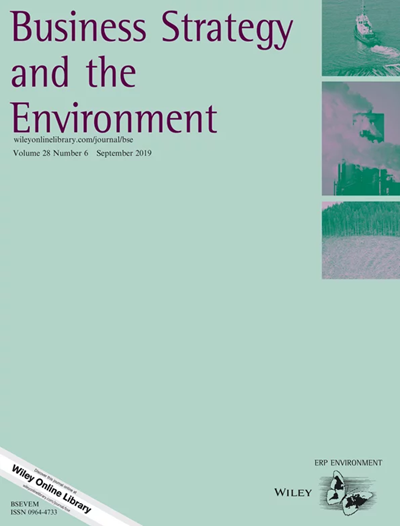Navigating Multilevel Environmental Pressures and Harnessing Digital Transparency as a Catalyst for Sustainable Innovation: Pathways to Enhanced Environmental Performance
IF 12.5
1区 管理学
Q1 BUSINESS
引用次数: 0
Abstract
This study examines how firms leverage sustainable innovation propensity and digital sustainability transparency as strategic resources to navigate multilevel environmental pressures and achieve environmental and innovation performance. The central theory guiding this research is the resource‐based view, which posits that firms gain competitive advantage through the effective management of valuable, rare, and inimitable resources. We collected the primary data from 182 employees of manufacturing firms in the United States and United Kingdom. The study found a positive association between various environmental pressures—competitors, government and employees, top management environmental awareness, and digital sustainability transparency. The results further signify that sustainability innovation propensity mediates the constructive association between digital sustainability transparency and innovation performance, as well as between digital sustainability transparency and environmental performance. The findings imply how an organization navigates the social environment and the external pressures coming from the government, competitors, and the employees. Organizational environmental changes and green business strategies can be effectively implemented through anticipatory environmental scanning and stakeholders' involvement. To manage these pressures, organizations are encouraged to establish a sustainability directorate, whose role would be to codify these signals into managerial implications continually.应对多层次环境压力,利用数字透明度作为可持续创新的催化剂:提高环境绩效的途径
本研究考察了企业如何利用可持续创新倾向和数字化可持续性透明度作为战略资源来应对多层次的环境压力,并实现环境和创新绩效。指导本研究的核心理论是资源基础观点,该观点认为企业通过有效管理有价值的、稀有的和不可复制的资源来获得竞争优势。我们收集了182名美国和英国制造企业员工的原始数据。研究发现,各种环境压力——竞争对手、政府和雇员、高层管理人员的环境意识和数字可持续性透明度之间存在正相关关系。研究结果进一步表明,可持续创新倾向在数字可持续发展透明度与创新绩效、数字可持续发展透明度与环境绩效之间起建设性的中介作用。这些发现暗示了一个组织如何驾驭社会环境和来自政府、竞争对手和员工的外部压力。通过预期的环境扫描和利益相关者的参与,可以有效地实施组织环境变化和绿色商业战略。为了管理这些压力,鼓励各组织设立可持续性理事会,其作用是不断地将这些信号编入管理影响。
本文章由计算机程序翻译,如有差异,请以英文原文为准。
求助全文
约1分钟内获得全文
求助全文
来源期刊

Business Strategy and The Environment
Multiple-
CiteScore
22.50
自引率
19.40%
发文量
336
期刊介绍:
Business Strategy and the Environment (BSE) is a leading academic journal focused on business strategies for improving the natural environment. It publishes peer-reviewed research on various topics such as systems and standards, environmental performance, disclosure, eco-innovation, corporate environmental management tools, organizations and management, supply chains, circular economy, governance, green finance, industry sectors, and responses to climate change and other contemporary environmental issues. The journal aims to provide original contributions that enhance the understanding of sustainability in business. Its target audience includes academics, practitioners, business managers, and consultants. However, BSE does not accept papers on corporate social responsibility (CSR), as this topic is covered by its sibling journal Corporate Social Responsibility and Environmental Management. The journal is indexed in several databases and collections such as ABI/INFORM Collection, Agricultural & Environmental Science Database, BIOBASE, Emerald Management Reviews, GeoArchive, Environment Index, GEOBASE, INSPEC, Technology Collection, and Web of Science.
 求助内容:
求助内容: 应助结果提醒方式:
应助结果提醒方式:


